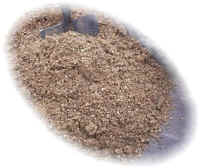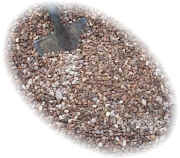|
|
|
|||||
|
|
||||||
|
||||||||||
|
Fast Growing Trees Fastest
Deciduous |
|
Faster
Deciduous |
|
Fast
Deciduous
Evergreen |
|
Fast Growing
Hedging Plants
Deciduous
Evergreen
Arborvitae
Douglas Fir |
|
Connected pages clay soil | extreme clay soil | plants for clay soil | compost 1 | compost 2 | compost 3 | improving the soil | pruning | soil types | the basics | Unwanted visitors |
|
|
Organic matter is needed in bulk, not as concentrated chicken manure pellets and the like, though these are good for adding nutrients.
Rather than spend huge amounts of time and energy digging it in (you can do this of course, but I'm assuming that you don't want to), use organic matter when planting and then after as a mulch.
Using a good soil conditioner when planting can gain a year or so of growth on plants compared to direct planting into the soil. Get them off to a good start and they'll never look back (Although this is not a universal panacea, no amount of soil improver will help the plant that is simply in the wrong place). Use the conditioner as a halfway stage between the soft compost of the pot the plants have been grown in, and the harsh reality of your garden soil.
Soil conditioners
 Horse manure |
 Sharp sand |
 Shingle |
Well-rotted
farmyard or horse manure
What's it like? - The best of all for my money. It conditions the soil and adds nutrients. Make sure it's well rotted, it should smell earthy, not pooey (please excuse me I have a small child) and be dark in color. If it's recently out of the animal it will smell like it, be mid brown rather than dark brown or black and probably have recognizable pieces of grass and straw mixed in. Don't use it without composting it for a few months. If it's like this, the poor little plant roots will curl up in disgust.
Where to get it
Sometimes available in bags from suppliers of topsoil and other bulk materials
Garden centers
If you live in or near the countryside, you may see bags for sale or even given away (I know of a riding school that has to bag it and take it to the local dump - criminal!). These sources may be of fresh manure, be sure to let it rot down before using it.
Garden
compost
What's it like? - Second only to farmyard manure, but not as many nutrients. If properly rotted it won't be at all unpleasantly smelly and shouldn't contain any recognizable plant material bar the odd bit of twig. How to make compost to gladden the hearts of a worm
Where
to get it
![]() Make it yourself.
Make it yourself.
![]() Bulk materials merchants and garden centers.
Bulk materials merchants and garden centers.
Peat
and Old Grow Bags
What's it like? - Generally very clean and pleasant to handle. Large compressed bales are best value (you may need help in handling them). Very good as soil structure conditioners but few nutrients. Use bonemeal or blood fish and bone at the same time to act as a slow release fertilizer. Not very environmentally friendly apparently, though opinions are divided.
Where
to get it
![]() Garden centers / DIY stores etc. last
year's grow bags, or even new this years.
Garden centers / DIY stores etc. last
year's grow bags, or even new this years.
Pea shingle
What's it like? - Pea shingle is sometimes called 10mm stone, it's fairly fine gravel. It is sometimes suggested that you can add sand to poorly drained soil, but this can actually make poorly drained soil worse, as its very small grains can block existing drainage channels.
Where to get it
![]() Builders merchants and plant hire
companies. In bulk 0.5 - 1 ton is the cheapest way, share with neighbors if
you don't need much.
Builders merchants and plant hire
companies. In bulk 0.5 - 1 ton is the cheapest way, share with neighbors if
you don't need much.
![]() Usually from the same source in bags. Don't get it from the garden center - very expensive.
Usually from the same source in bags. Don't get it from the garden center - very expensive.
Others
- Spent mushroom compost, composted paper waste, composted bark, spent hops from
breweries, seaweed etc.
Depending on where you live, these or others may be available cheaply or for free. The main criteria is always that the conditioner should be crumbly, not smelly and with no or few recognizable raw materials. If you can get it in the raw state, e.g. seaweed, then compost it down first as any other organic matter before using on the garden.
Take care though when using any of these, don't use them initially as freely as you might the tried and trusted conditioners. Mushroom compost for instance often has very high levels of lime, so your acid lovers will hate it. Try a small amount in a restricted area first before you order in a truck full.
Personally, I have used composted bark and coir (coconut fibres). I have found both to be reasonable soil conditioners if not always really well rotted enough out of the bag. If using these use a concentrated fertilizer as with peat.
| Tip If you want to improve the soil but don't want to physically dig the organic matter into the soil, spread it on the surface between autumn and spring and let the worms take it down for you. (This doesn't work with sand and gravel!) |
The key thing about bulk organic material is the word BULK, use lots of it! An averagely poor soil in a garden of medium size can swallow a ton without much difficulty, so don't worry too much about over-ordering, use lots of it!
|
Received by email I am looking for natural alternatives to manure for a vegetable garden and have come across 'shoddy', what is this and how is it good for the garden or are you able to point me in the right direction for finding out. Paul, webmaster I've not come across it before let alone used it, but a Google search gave me this: "Shoddy Wool waste or shoddy is a by-product of the textile industry and can sometimes be obtained in industrial areas. It contains a good supply of nitrogen and rots down fairly quickly in the soil. It is best dug in during autumn and winter. Application rate: 11lb (5kg) per square yard (metre)." |
|
|
|
About us. General queries and emails to |
|
Copyright © Paul Ward 2000 - 2012 |